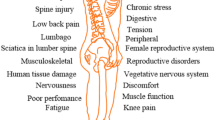Abstract
Shock-type vibrations are frequently experienced in vehicles excited by impulsive input, such as bumps in the road, and cause discomfort. Current national and international standard weightings were primarily developed for assessing exposure to sinusoidal or random vibrations and not impulsive excitations or shocks. In this experimental study, various shock signals were systematically produced using the response of a one degree-of-freedom vibration model to hanning-windowed half-sine force input. The fundamental frequency of the shock was varied from 0.5 to 16 Hz at a step of 1/3 of an octave. The magnitude estimation method was used for fifteen subjects to compare the discomfort of shocks with various unweighted vibration dose values between 0.35 ms−1.75 and 2.89 ms−1.75 at each frequency. The equivalent comfort magnitude of shock showed greater sensitivity at frequencies less than 0.63 Hz and at the resonance frequency of the human body between 5.0 Hz and 6.3 Hz. The frequency weighting constructed by using both the equivalent comfort magnitude and the growth rate of discomfort obtained in this study was compared with the current standard weightings, Wb of BS 6841 and Wk of ISO 2631. The derived weightings for shock were applied to the acceleration of the shocks, and an enhanced correlation was proved between the magnitude estimations and the weighted physical magnitude of shock.
Similar content being viewed by others
References
Ahn, S. J. and Griffin, M. J. (2008). Effects of frequency, magnitude, damping, and direction on the discomfort of vertical whole-body mechanical shocks. J. Sound and Vibration 311,1–2, 485–497.
Ahn, S. J., Griffin, M. J. and Jeong, W. B. (2006). Development of frequency weighting shape for evaluation of discomfort due to vertical whole-body shock vibration. Trans. Korean Society for Noise and Vibration Engineering 16,6, 659–665.
Ahn, S. J., Griffin, M. J., Yoo, W. S. and Jeong, W. B. (2007). Study on discomfort of vertical whole-body shock vibration having various magnitudes, frequencies and damping. Trans. Korean Society of Automotive Engineers 15,2, 1–8.
British Standards Institution (1987). Measurement and Evaluation of Human Exposure to Whole-body Mechanical Vibration and Repeated Shock. BS 6841.
Dupuis, H., Hartung, E. and Haverkamp, M. (1991). Acute effects of transient vertical whole-body vibration. Occupational and Environmental Health, 63, 261–265.
Griffin, M. J. (1990). Handbook of Human Vibration. Academic Press. London.
Griffin, M. J. (1998). A comparison of standardized methods for predicting the hazards of whole-body vibration and repeated shocks. J. Acoustical Society of America 215,4, 883–914.
Griffin, M. J. and Whitham, E. M. (1980). Discomfort produced by impulsive whole-body vibration. J. Acoustical Society of America 68,5, 1277–1284.
Huston, D. R., Zhao, X. and Johnson, C. C. (2000). Wholebody shock and vibration: Frequency and amplitude dependence of comfort. J. Sound and Vibration 230,4, 964–970.
International Organization for Standardization (1997). Mechanical Vibration and Shock-evaluation of Human Exposure to Whole-body Vibration. ISO 2631-1.
Jang, H. K. (2004). Design cuideline for the improvement of dynamic comfort of a vehicle seat and its application. Int. J. Automotive Technology 6,4, 383–390.
Kim, M. S., Kim, Y. T., Moon, W. K., Ahn, S. J. and Yoo, W. S. (2007). Correlation between subjective and objective assessments of ride comfort. Trans. Korean Society of Automotive Engineers 15,5, 56–62.
Matsumoto, Y. and Griffin, M. J. (2005). Nonlinear subjective and biodynamic response to continuous and transient whole-body vibration in the vertical direction. J. Sound and Vibration 287,4–5, 919–937.
Siegel, S. and Castellan, N. J. (1988). Nonparametric Statistics for the Behavioral Sciences. 2nd Edn. McGraw-Hill. Boston.
Spang, K. (1997) Assessment of whole-body vibration containing single event shocks. Noise Control Engineering J. 45,1, 19–25.
Wikstrom, B. O., Kjellberg, A. and Dallner, M. (1991). Whole-body vibration: A comparison of different methods for the evaluation of mechanical shocks. Int. J. Industrial Ergonomics, 7, 41–52.
Yoo, W. S., Park, D. W., Kim, M. S. and Hong, K. S. (2004). Optimum air pressure for an air-cell seat to enhance ride comfort. Int. J. Automotive Technology 6,3, 251–257.
Yoo, W. S., Park, S. J., Park, D. W., Kim, M. S., Lim, O. K. and Jeong, W. B. (2006). Comparison of ride comforts via experiment and compurer simulation. Int. J. Automotive Technology 7,3, 309–314.
Author information
Authors and Affiliations
Corresponding author
Rights and permissions
About this article
Cite this article
Ahn, S.J. Discomfort of vertical whole-body shock-type vibration in the frequency range of 0.5 to 16 Hz. Int.J Automot. Technol. 11, 909–916 (2010). https://doi.org/10.1007/s12239-010-0108-z
Received:
Revised:
Published:
Issue Date:
DOI: https://doi.org/10.1007/s12239-010-0108-z




